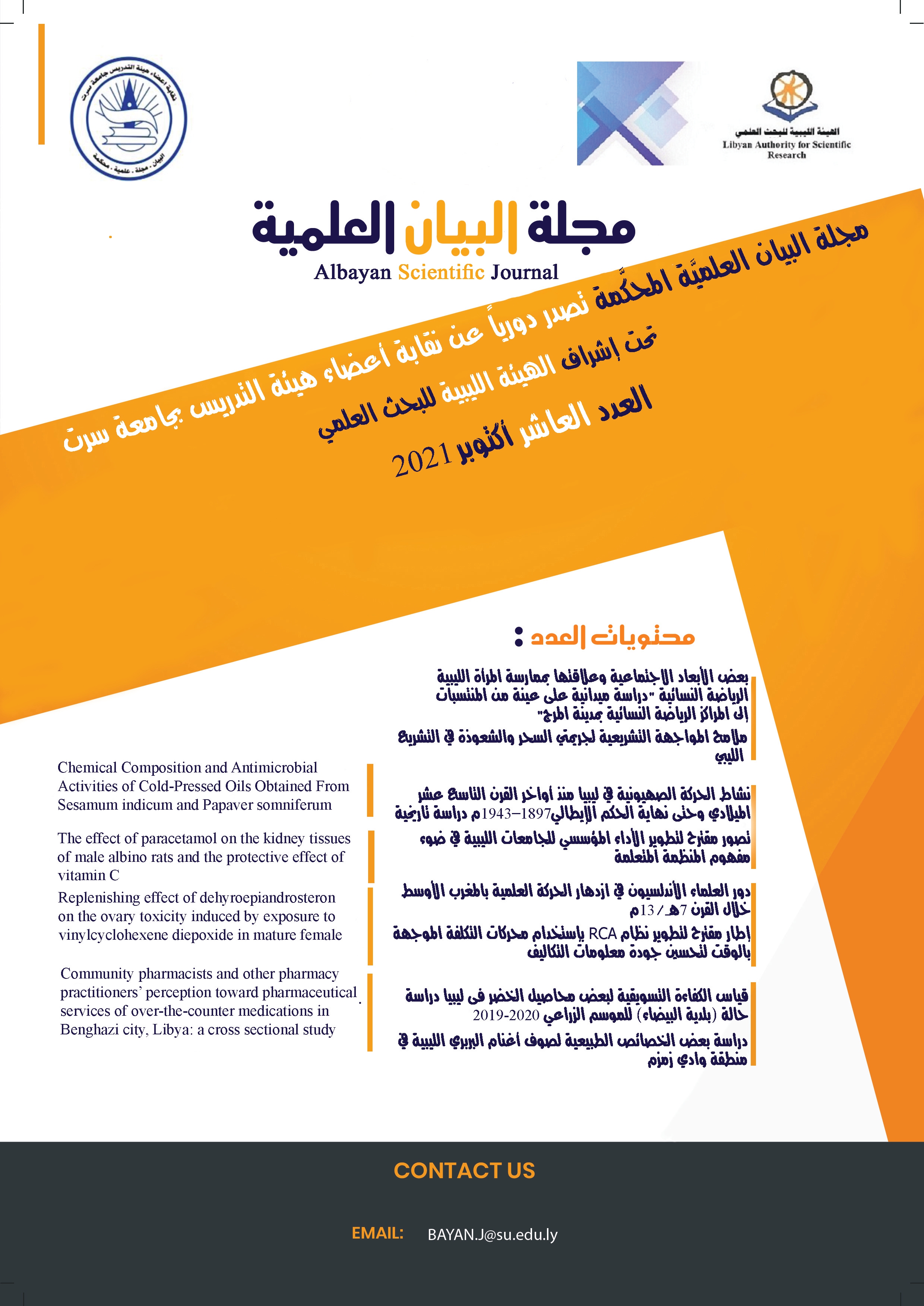Molecular Characterization of Biosurfactant Producing Lactobacillus strains and their Physicochemical Properties
DOI:
https://doi.org/10.37375/bsj.vi10.2350Keywords:
Biosurfactant,, Emulsification index,, Surface tension,, critical micelle concentration,, L. acidophilus,, L. pentosusAbstract
Biosurfactants or surface-active compounds are biodegradable, non-toxic and ecofriendly compounds released by microorganisms. Biosurfactants are amphiphilic compounds cause surface tension reduction both aqueous solutions and hydrocarbon mixtures. The main purpose of this work was to characterize biosurfactant produced by Lactobacillus strains. Identification using 16s rDNA identified the isolates as L. acidophilus Effect different parameters (temperature, PH and Salinity) were studied to evaluate the stability of biosurfactant after treatment. In addition, critical micelle concentration of biosurfactant, emulsification index and viscosity reduction of palm and engine oils have been studied. The results revealed that, the biosurfactant from L. acidophilus and L. pentosus maintains its emulsifications activities unaffected in the wide range of parameter's study except slightly decreasing in emulsification index values at salinity 15%. The maximum reduction in surface tension was 18.05 mN/m with minimum concentration of critical micelle concentration of 7.5 mg/ml and high decrease of palm and engine oil viscosity of 110.1 and 165.3% respectively. This study concluded that, the emulsification activity, the surface activity and the stability to heat treatment, different PH and salinity of biosurfactant of Lactobacillus strains revealed the application of the biosurfactant in food, pharmaceutical, cosmetics industries and oilrecovery.
References
Rferences
Cameotra, S.S., Makkar, R.S., Kaur, J, & Mehta, S.K. 2010. Synthesis of biosurfactants and their
advantages to microorganisms and mankind. Adv. Exp. Med. Biol., 672:261–280.
Mukherjee, S., Das,P., & Sen, R. 2006. Towards commercial production ofmicrobial
surfactants.TrendsBiotechnol 24, 509–515.
Banat. I. M., Franzetti.A., Gandolfi. I., Bestetti .G,mMartinotti M. G., Fracchia, L., Smyth,T.J.,
& Marchant, R. 2010. Applied Microbiology and Biotechnology June, 87, 2: 427 444.
Mcinerney, M. J., Javaheri, M. & Nagle, D. P. 1990. Properties of the biosurfactant produced by
Bacillus licheniformis strain JF-2. J. Ind. Microbiol., 5, 95-102.
Conter, M., Muscariello, T., Zanardi, E., Ghidini, S., Vergara, A., Campanini, G. &Lanieri, A. 2005. “Characterization of Lactic Acid Bacteria Isolated from an Italian Dry Fermented Sausage”.
Romanian Biotechnological Letters. Vol. 14: p. 167-174.
Yin, H., J. Qiang, Y. Jia, J. Ye, Peng, H. Qin, N. Zhang & B. He. 2009. Characteristics of biosurfactant produced by Pseudomonas aeruginosa S6 isolated from oil-containing wastewater.
Process Biochemistry. Vol. 44: p. 302-308.
Cooper, D. G &Goldenberg, B. G. 1987. Surface-Active Agents from Two Bacillus Species.
Appl Environ Microbiol , 53(2): p. 224–229.
El-Sersy, N. 2012. Plackett-Burman design to optimize biosurfactant production by marine
Bacillus subtilis N10. Rom. Biotechnol. Lett. 17 (2), 7049–7064.
Anandaraj B, Thivakaran P. 2010. Isolation and production of biosurfactant producing organism
from oil spilled soil. J Biosci Tech 1: 120–126.
Devesa-Rey R., Bustos G., Cruz, J.M. &Moldes, A.B. 2011. Optimisation of entrapped activated
carbon conditions to remove coloured compounds from winery wastewaters. Bioresource Technology, 102, 6437–6442.
Jara AM, Andrade RF, & Campos-Takaki GM. 2013. Physicochemical characterization of tensio- active produced by Geobacillus stearothermophilus isolated from petroleum-contaminated soil.
Colloids Surf. B Biointerf. 101:315-318.
Augustin, M & Hippolyte, M. T. 2012. Screening of biosurfactants properties of cell-free supernatants of cultures of Lactobacillus spp. isolated from a local fermented milk (Pendidam) of Ngaoundere (Cameroon). International Journal of Engineering Research and Applications. Vol. 2
(5): p. 974-985.
Desai, J.D., & Banat, I.M. 1997. Microbial production of surfactant and their commercial
potential. Microbiology and Molecular Biology Reviews. Vol. 61: p.47–64, 1997.
Eduardo J., Gudina, J.,José A., Teixeira &Lígia R. Rodrigues. 2011. Biosurfactant-Producing Lactobacilli: Screening, Production Profiles, and Effect of Medium Composition. Applied and
Environmental Soil Science. Article ID 201254.
Khopade, A., Biao, R., Liu, X., Mahadik, K., Zhang, L &Kokare, C. 2012. Production and
stability studies of the biosurfactant isolated from marine Nocardiopsis sp. B4. Desalination 3, 198–204.
Augustin, M., Hippolyte, M.T &Ra€ıssa, K.R., 2013. Antibacterial activity of Lactobacillus’
biosurfactants against Pseudomonas spp. isolated from fresh beef. Novus Int. J. Biotechnol. Biosci., 2, 7–22.
Gudina, E. J., Teixeira, J.A. & Rodrigues, L. R. (2010). Isolation and functional characterization of a biosurfactant produced by Lactobacillus paracasei. Colloids and Surfaces B: Biointerfaces,
:298-304.
Augustin, M., Majesté, P. M., Hippolyte, M.T & Léopold, T. N. 2015. Effect of Biosurfactants
Extracted from a Locally Fermented Milk (Pendidam) on Its Shelf Life. Journal of Advances in
Biology & Biotechnology. Vol. 3(1): p. 12-22.
Rodrigues, L., Banat, IM., Teixeira, J & Oliveira, R. 2006. Biosurfactants: potential applications
in medicine. J Antimicrob Chemother. Vol. 57: p. 609–618.
Joshi, S., Bharucha, C. & Anjana. 2008. “Production of biosurfactant and antifungal compound by fermentedfoodisolateBacillussubtilis20B”.J.DesaiBioresourceTechnology.Vol. 99. p.
–4608.
Fernandes, E.C.Retal. 2013. “Study of Biosurfactant “Cocktails” with EnhancedProperties.
(Master Thesis)”. Minho's University, Portuguese. pp. 3.
Rodrigues, L., Teixeira, J., Oliveira, R. & Van der Mei, H. 2005. “Response surface optimization of the medium components for the production of biosurfactants by probiotic bacteria”. Process
Biochemistry. Vol. 41: p.1-10.
FracchiaL, Cavallo M, AllegroneG & Martinotti MG. 2010. ALactobacillus-derived
biosurfactant inhibits biofilm formation of human pathogenic Candida albicans biofilm producers. Appl Microbiol Biotechnol 2:827–837.
Batista, S.B., A.H. Mounteer, F.R. Amorim, & M.R. Totola. 2006. Isolation and characterization of biosurfactant/bioemulsifier-producing bacteria from petroleum contaminated sites. Bioresource
Technology. Vol. 97: p. 868-875.
Siripun, S. 2011. Isolation of Biosurfactant–Producing Bacteria with Antimicrobial Activity
against Bacterial Pathogens. Environment Asia. Vol. 4 (1): p. 1-5.
Bento, M., Camargo, F. D. O., Okeke, BC &Frankenberger WT Jr. 2005. Diversity ofbiosurfactant producing microorganisms isolated from soils contaminated with diesel oil.
Microbiol Res. Vol. 160 (3): p. 249-255.
Satpute, S.K., Banat, I.M., Dhakephalkar, P.K., Banpurkar, A.G., et al., 2010. Biosurfactants, bioemulsifiers and exopolysaccharides from marine microorganisms. Biotechnol. Adv., 28, 436–
Cooper, D. G., C. R. MacDonald, S. J. B. Duff, & N. Kosaric. 1981. Enhanced production of surfactin from Bacillus slubtilis by continuous product removal and metal cation additions. Appl.
Environ. Microbiol., 42:408-412, 1981.
Nadielly R. Andrade Silva, Marcos A. C. Luna,André L. C. M. A. Santiago, Luciana O. Franco, Grayce K. B. Silva,Patrícia M. de Souza, Kaoru Okada,Clarissa D. C. Albuquerque, Carlos A.Alves da Silva,andGalba M. Campos-Takaki. 2014. Biosurfactant-and-Bioemulsifier Produced by a Promising Cunninghamellaechinulata Isolated from Caatinga Soil in the Northeast ofBrazil.
Campos-Takaki Int. J. Mol. Sci. 2014, 15, 15377-15395.
Extracted from a Locally Fermented Milk (Pendidam) on Its Shelf Life. Journal of Advances in
Biology & Biotechnology. Vol. 3(1): p. 12-22.
Rodrigues, L., Banat, IM., Teixeira, J & Oliveira, R. 2006. Biosurfactants: potential applications
in medicine. J Antimicrob Chemother. Vol. 57: p. 609–618.
Joshi, S., Bharucha, C. & Anjana. 2008. “Production of biosurfactant and antifungal compound by fermentedfoodisolateBacillussubtilis20B”.J.DesaiBioresourceTechnology.Vol. 99. p.
–4608.
Fernandes, E.C.Retal. 2013. “Study of Biosurfactant “Cocktails” with EnhancedProperties.
(Master Thesis)”. Minho's University, Portuguese. pp. 3.
Rodrigues, L., Teixeira, J., Oliveira, R. & Van der Mei, H. 2005. “Response surface optimization of the medium components for the production of biosurfactants by probiotic bacteria”. Process
Biochemistry. Vol. 41: p.1-10.
FracchiaL, Cavallo M, AllegroneG & Martinotti MG. 2010. ALactobacillus-derived
biosurfactant inhibits biofilm formation of human pathogenic Candida albicans biofilm producers. Appl Microbiol Biotechnol 2:827–837.
Batista, S.B., A.H. Mounteer, F.R. Amorim, & M.R. Totola. 2006. Isolation and characterization of biosurfactant/bioemulsifier-producing bacteria from petroleum contaminated sites. Bioresource
Technology. Vol. 97: p. 868-875.
Siripun, S. 2011. Isolation of Biosurfactant–Producing Bacteria with Antimicrobial Activity
against Bacterial Pathogens. Environment Asia. Vol. 4 (1): p. 1-5.
Bento, M., Camargo, F. D. O., Okeke, BC &Frankenberger WT Jr. 2005. Diversity ofbiosurfactant producing microorganisms isolated from soils contaminated with diesel oil.
Microbiol Res. Vol. 160 (3): p. 249-255.
Satpute, S.K., Banat, I.M., Dhakephalkar, P.K., Banpurkar, A.G., et al., 2010. Biosurfactants, bioemulsifiers and exopolysaccharides from marine microorganisms. Biotechnol. Adv., 28, 436–
Cooper, D. G., C. R. MacDonald, S. J. B. Duff, & N. Kosaric. 1981. Enhanced production of surfactin from Bacillus slubtilis by continuous product removal and metal cation additions. Appl.
Environ. Microbiol., 42:408-412, 1981.
Nadielly R. Andrade Silva, Marcos A. C. Luna,André L. C. M. A. Santiago, Luciana O. Franco, Grayce K. B. Silva,Patrícia M. de Souza, Kaoru Okada,Clarissa D. C. Albuquerque, Carlos A.Alves da Silva,andGalba M. Campos-Takaki. 2014. Biosurfactant-and-Bioemulsifier Produced by a Promising Cunninghamellaechinulata Isolated from Caatinga Soil in the Northeast ofBrazil.
Campos-Takaki Int. J. Mol. Sci. 2014, 15, 15377-15395.














